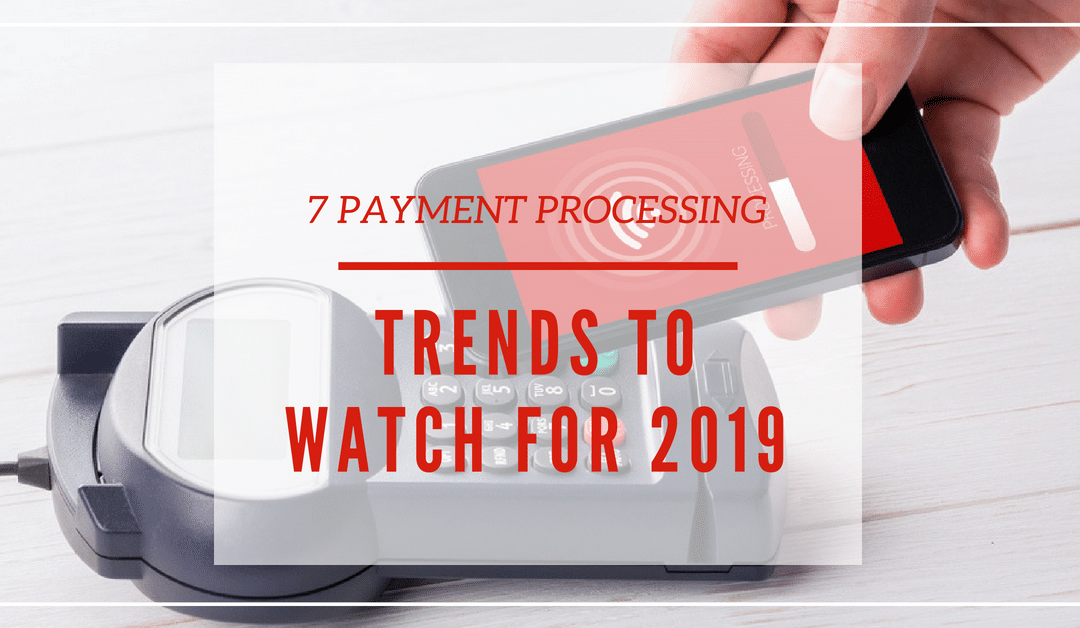Consumers are becoming more familiar with alternative payment methods and more confident in their security. As these payment options continue to gain in popularity, businesses need to adapt to consumer preferences — and having a clear understanding of the latest payment processing trends can help them make the right decisions for their future.
For business owners looking to stay relevant with a diverse group of consumers, more flexible payment solutions are necessary. But first, it’s important to have a firm grasp on what’s happening in this growing market. Below are seven payment processing trends to watch for in 2019:
In-store mobile payments to overtake credit cards
Chief among the leading payment processing trends for next year is the steady emergence of in-store mobile payments as the primary payment method in the U.S. By 2020, in-store mobile payments are expected to overtake credit cards, at $503 billion. The added speed and convenience of in-store mobile payments is particularly attractive to a younger generation of consumers. Demographic info of note: At 73 million, millennials are expected to overtake Boomers in population in 2019. Meanwhile, generation X is projected to pass the Boomers in population by 2028.
Increased prominence of mobile wallets
The convenience of mobile wallets is appealing for the consumer: Mobile wallet transactions tend to be quicker than paying by cash or credit card. When the consumer is ready to make their purchase, all they need to do is open the app, touch their phone to the compatible reader located next to the register, and the transaction is complete. Added security is also a plus. Unlike cash and credit cards, the card information a customer puts into a mobile wallet is encrypted, requiring them to unlock their device and use a passcode or fingerprint.
Apple Pay, Google Wallet, Android Pay, and Samsung Pay are the top mobile wallets currently used at small and medium businesses.. Apple Pay and Google Wallet are expected to continue battling it out for the top spot into 2019 and beyond, but Android Pay and Samsung Pay still have their share of supporters.
Payment methods of online shoppers
The most popular payment methods for online shoppers include credit cards, electronic payment, and debit cards, respectively. While it’s unnecessary to offer every single payment method, merchants will want to have an understanding of which methods their consumers prefer and select a merchant service provider who can support their specific needs. The exact combination will depend on your customer base. Not only learning the latest payment processing trends, but understanding how they apply to your unique situation, is essential to giving yourself a powerful advantage in today’s market.
mPOS devices rise in popularity
According to TYSY, roughly 27.7 million mPOS devices will be in circulation in the U.S. within the next three years, almost 10 times the amount in 2014. An mPOS device can be cost-effective for small and medium business owners, who have limited staff and resources for electronic registers and software support. The average credit card processing cost for a retail business is around 2 percent for cards that are physically swiped in-person, compared with 2.3 percent to 3.1 percent for card-not-present transactions.
Blockchain technology offers benefits
Beyond giving consumers more payment options, blockchain technology gives small businesses the opportunity to reduce costs by allowing them to work directly with other businesses. Over the next five years, blockchain technology is expected to reduce the cost of accounting reconciliation by 70 percent and compliance costs by up to 50 percent. Along with reduced financial burden, the blockchain boasts improved transparency and security for both businesses and consumers. Information housed in the blockchain is entirely decentralized, rather than stored in one location.
Biometric authentication enhances consumer security
Biometric authentication — examples include fingerprint ID and financial recognition — will be used in more than 18 billion transactions by 2021. Apple Pay and Samsung Pay both use fingerprint identification, but not all platforms offer these levels of security. But the technology as a whole is more reliable and cost-effective, reducing password administrations costs and decreasing the likelihood of loss prevention. With the steady increase in fraudulent transactions and security breaches, adoption of this technology is essential to making customers feel more at ease with making their purchase.
The improved customer experience
Perhaps the most important of all payment processing trends is the renewed emphasis on the customer experience. Today’s alternative payment options are not replacements, but rather improvements on previous methods. Younger generations agree: More than 60 percent of millennial and Generation Z customers willing to share their bank account credentials with third-party vendors. That total will only increase as customers become more familiar with alternative payment options.
As a business owner, keeping an eye on the future and staying informed about the latest payment processing trends is an invaluable part of increasing sales and improving customer satisfaction. In this ever-changing environment, there’s much to look forward to as we approach 2019.



